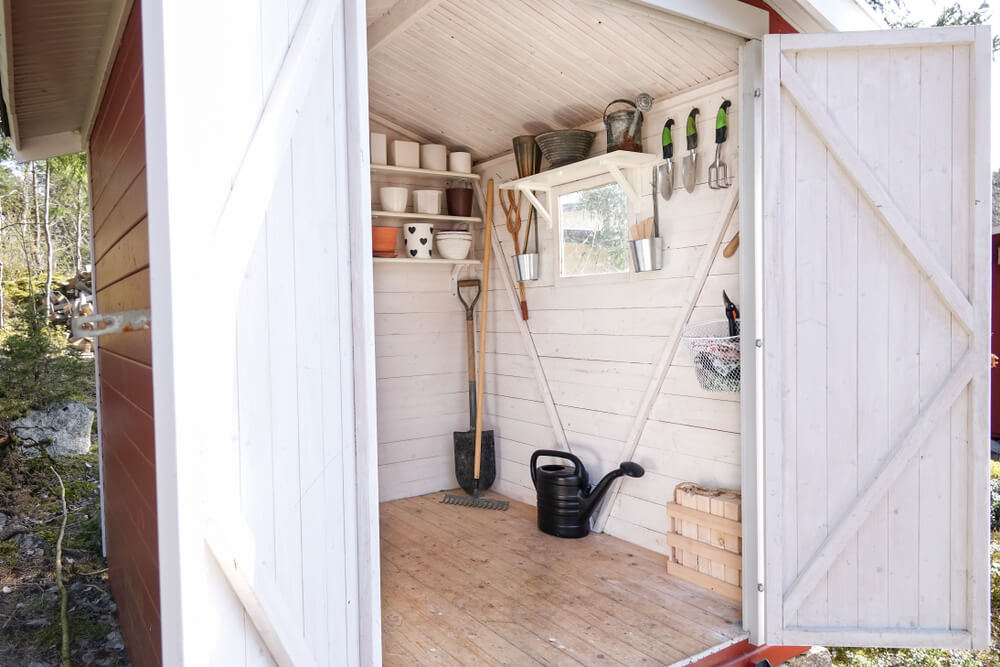
There’s nothing more frustrating than walking into your shed at the start of a project, filled with motivation, only to fumble around and trip over boxes searching for the right tools. What was once a convenient storage space is now an overwhelming mess. If you can relate, it’s time to declutter with our five tips on how to organize your shed.
What Is Okay to Store in a Shed?
While it might be tempting to toss all your miscellaneous junk straight into your shed, take a moment to think. Here are some questions to ask yourself when deciding what to store:
- Is the item temperature sensitive?
- Will it be damaged from humidity or moisture?
- Can it attract or be damaged by pests?
If the answer is no to all three questions, then your shed is the perfect home! Some common products people store in their shed are:
- Outdoor equipment (lawnmowers, weed whackers, etc.)
- Gasoline
- Lawn and garden chemicals (check if they have temperature restrictions first)
- Power tools (but keep the batteries inside so they are not exposed to heat)
- Seasonal outdoor decorations
- Outside toys or games
- Lawn furniture over Winter
What Shouldn’t Be Stored in a Shed
If you answered yes to any of the questions above, think twice before storing that item in your shed. Some products can’t handle temperature fluctuations. Others may be damaged from moisture or attract rodents and pests.
We recommend NOT storing the following items in your shed:
- Chemicals with storage temperature restraints
- Canned goods (may explode if exposed to extensive heat)
- Wooden furniture
- Art and photographs
- Appliances (they will rust from moisture)
- Documents or paper of any kind
- Paint (sensitive to temperature changes that may affect its consistency)
- Pet food and treats
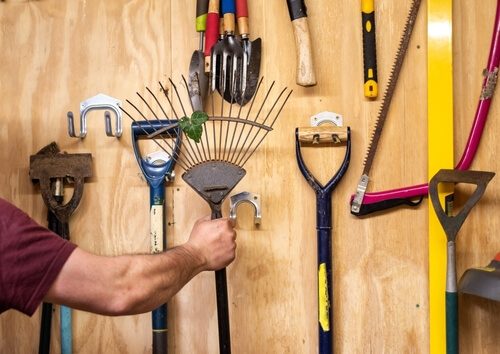
Tips for How to Organize Your Shed
Now that you know what to store in your shed, we need to discuss how to store it. The following are our top five shed organization ideas to make the most of your space.
Shed Organization Tip #1: Utilize All Your Space
Looking to declutter your shed and make things easier to find? The first step is using ALL your space. This includes the floor, walls, doors, exterior, and even the ceiling! The best way to do this is by removing everything from your shed and giving it a deep clean. Then you can see exactly what you’re working with.
As you begin reorganizing, get creative with how you use your available surfaces. Consider hanging things on the back of the door, installing bins on the ceiling, or adding shelves above doorways. You can even renovate your shed or build a loft!
For items that can handle the outdoors, consider storing them on and around your shed. Use hooks to hang things like kayaks, tools, or outdoor furniture on the exterior wall. This frees up space inside for items that need more protection.
The size of your structure makes a big difference. We offer dozens of shed styles and sizes ranging from 6’ x 6’ to 14’ x 44’. No matter which size you have, we know there are creative ways you can take advantage of the space while you’re learning how to organize a shed.
Shed Organization Tip #2: Shelving
Every organization-lover knows that shelves are essential. They free up floor space, help you avoid precarious stacks of boxes, and declutter your area. Some storage shed shelving ideas to try:
- Floating Shelves — These add a minimalistic look while still providing extra space.
- Freestanding Shelves — Don’t want to deal with installation? Freestanding shelving units are a solid alternative. Just make sure their material (wood, metal, or plastic) can handle the conditions inside your shed.
- Shelves on Wheels — Upgrade your free-standing shelves by getting a set on wheels so you can easily move them wherever works best.
- Adjustable Shelves — The flexibility of adjustable shelves is great if you’re frequently swapping items in and out.
- DIY Shed Shelves — If you’re handy, give yourself a weekend project and build your own with some plywood and 2x4s.
- Bookshelves and Shoe Racks — Before buying (or building) something new, we always recommend looking at what you already have. You can repurpose an old bookshelf or shoe rack for a quick and simple storage solution.
These storage shed shelving ideas are helpful, but the hard part is organizing them. We suggest putting seasonal or infrequently used items on higher shelves to keep them out of the way. Then you can use lower shelves with convenient access to items you need often. Remember to swap things out throughout the year, like Christmas decor or gardening supplies.
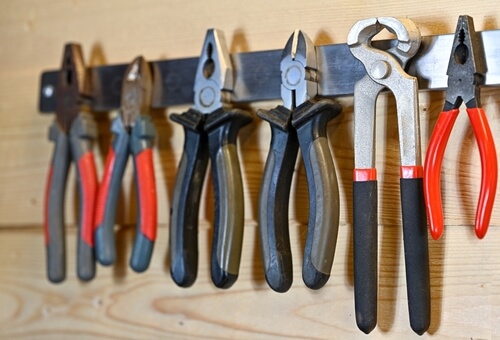
Shed Organization Tip #3: Hanging Tools and Equipment
When you’re learning how to organize a shed, awkwardly shaped tools and equipment are a pain. Make storing them a breeze with our favorite solution: hanging!
- Pegboard Wall — Cut your pegboard to the correct shape and size and add hooks to hang your supplies. Everything is simple to rearrange if needed.
- Magnetic Strip — Attach your metal tools to a magnetic strip along the wall, making it easy to locate whatever item you need.
- Utility Hooks — These sturdy hooks can keep large items like chairs, bikes, and sports equipment from cluttering your floor.
Whether you’re using hooks, rails, or magnets, hanging your items is a great way to utilize your wall space. And when you can see everything in one spot, you avoid rifling through drawers and boxes in search of what you need.
Shed Organization Tip #4: DIY Storage
What about those miscellaneous tools that never seem to have a home? We have several DIY shed organization ideas for you to implement.
Our first idea for how to organize a shed DIY-style is to head to the kitchen. Grab a few empty jars to sort and store loose hardware like nails and screws. Always make sure you label them (future you will thank you). When the jars are full, you can either sit them on a shelf or create your own mason jar holder.
Looking for a way to store rakes, shovels, and other long-handled tools? Make your own shovel rack with a little bit of wood and a free afternoon. This project is beginner-friendly and perfect for any DIYer.
No shed is complete without a mess of cords and hoses. Prevent these from getting tangled with hooks, PVC pipe, or one of our favorite shed organizers: the five gallon bucket. Just mount it to your wall with the open end facing out and wrap your cord or hose around the outside. Now you can store things inside the bucket as well!
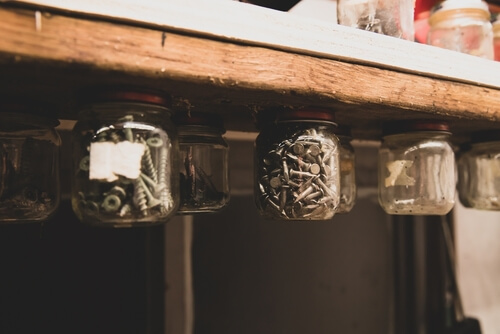
Shed Organization Tip #5: Develop a System
Of all our tips, this one is the most important. Living clutter-free begins with developing a storage shed organization system and sticking to it.
- Keep It Clean — Don’t let your shed get out of control. Keep it clean, organized, and well-maintained as you go.
- Be Intentional — Every item in your shed should be thoughtfully placed. Don’t just throw things in there randomly.
- Label Everything — From boxes to mason jars, make sure everything is accurately labeled so you don’t have to go on a wild goose chase in search of what you need.
- When In Doubt, Stack It — Plastic tubs and wooden crates are great storage containers because they stack easily which maximizes your space.
Your storage shed organization system should be customized to you! No matter what system you develop, make sure it’s realistic to maintain and that it works for your lifestyle.
Looking to Upgrade Your Outdoor Storage?
Browse our selection of wood and vinyl sheds and customize your own for the perfect storage solution.
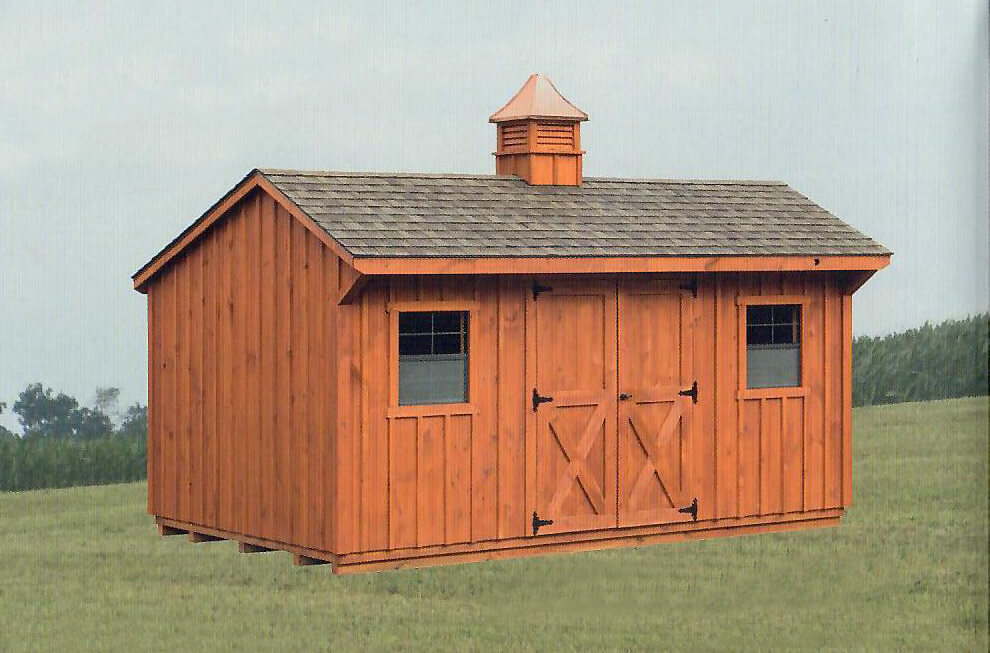
This blog was originally published on July 6, 2020. It was updated on June 27, 2024.
